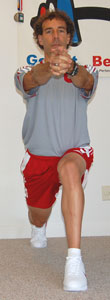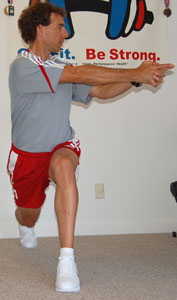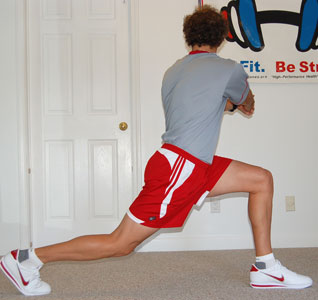| Ron Jones Bio |
| CorporateWellness |
| Coach & Train |
| Exercise Library |
| Handouts |
| Health & Fitness |
| KETTLEBELLS |
| Products by RJ |
| Site Map |
Legs: "Rotational Lunge"



This is a "2-Phase" movement--lunge
first then rotate from core/trunk.
Directions: Perform my
Dynamic Warm-Up
exercises at “beginning” of workout
for maximum benefit and improvement.
Pick a safe level; never be unsafe or exceed your capacity to “control” your
body!
-
Drop into a deep lunge while keeping knee DIRECTLY over the ankle of front foot.
-
After deep lunge, rotate to "outside" of lead leg as you point straight arms to side.
-
Option #1-Returning Lunge: As you stand back out of the lunge, "push off" as you step back and bring your feet together. Repeat with opposite leg.
-
Option #2-Walking Lunge: After returning to center, take one large step all the way over then drop into the next lunge. Do NOT put feet together before lunging again! Every step you take will be a deep lunge.
![]() Tips: With the Returning Lunge, the key is to "press off" with a little speed
as you step back so you don't drag your foot or "stick" your foot
on the floor.
With the Walking Lunge, make sure to take one big step right into the next
lunge. Don't rush this exercise trying to do both the lunge and rotation at the
same time because you'll jack them up! This is a 2-Phase movement!
Go slow enough to "sink" into the deeper lunge to get the maximum strength
and flexibility benefits then do your rotation. By breaking it up into
two parts, you'll get the maximum leg strength/stability benefits and maximum spinal
mobility/stability benefits.
Tips: With the Returning Lunge, the key is to "press off" with a little speed
as you step back so you don't drag your foot or "stick" your foot
on the floor.
With the Walking Lunge, make sure to take one big step right into the next
lunge. Don't rush this exercise trying to do both the lunge and rotation at the
same time because you'll jack them up! This is a 2-Phase movement!
Go slow enough to "sink" into the deeper lunge to get the maximum strength
and flexibility benefits then do your rotation. By breaking it up into
two parts, you'll get the maximum leg strength/stability benefits and maximum spinal
mobility/stability benefits.
-
One great benefit of lunges (especially the Rotational Lunge version above) is not even general leg strength, but rather, the lateral core, hip, knee, ankle, and foot stability challenge. This is a great way to increase lateral stability challenge and improvement. Awesome exercise if you ski, skate, snowboard, surf, or participate in other balance-challenging sports with degrees of instability.
-
For progressions, try the BOSU Lunge or BOSU Rotational Lunge.
*Note: These exercises are intended for "normal healthy" individuals and many are only intended for competitive athletes. If you have an injury, or abnormal pain is present, see your physician or a certified physical therapist before continuing your exercises.
RonJones.Org | Back to BodyXercise Library | Site Map
(Updated 6.15.08)
